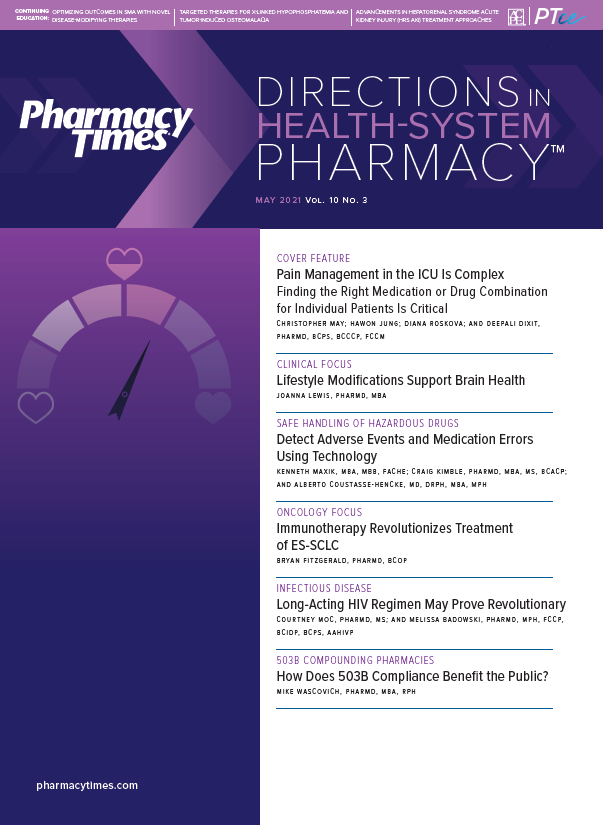Publication
Article
Pharmacy Practice in Focus: Health Systems
Detect Adverse Events and Medication Errors Using Technology
Author(s):
Digital tools can help pharmacists and other health care providers ensure effective and safe drug use.
Technology has changed the practice of pharmacy. Many systems are now part of an ever-increasingly interfaced or integrated health care system allowing the electronic exchange of prescriptions from electronic health records (EHRs) to the pharmacy information system and bidirectional data exchange for many items, such as lab results and test information. With meaningful use of automated distribution cabinet databases, EHR efforts, electronic data exchange, and smart pump technology, the availability of data to use for addressing and preventing adverse medication events has grown.1,2 Use of these systems has allowed a data-rich environment to store and retrieve reporting. Mining data is becoming easier and can be used as a tool to identify adverse medication events or potential events.3,4
EHR AND E-PRESCRIBING
The EHR supports an enterprise-wide view of patient care delivered in both the inpatient and outpatient settings.5 Achieving meaningful use and interoperability with EHRs has improved 2 critical aspects of the medication management system: conducting a medication reconciliation and reducing transcription errors during medication ordering. However, even with increased legibility and transcription, EHRs can only be as good as the data entered, the review process, and their sources.6-8
To catch potential medication errors using EHRs, pharmacy staff members generate reports to determine the number of profiles or identified patient populations who are high-risk. Employees review data to determine whether communication handoffs exist among the varying levels of care and whether data received at the time of admission or care were accurate.8,9
An EHR can be built during the ordering process to include dose range, drug information resources, frequency, lab result limits, medication route, and required testing. In addition, a drug interaction screening system is often layered to prevent medication misadventures. Staff members can analyze data from the EHR to look at tool use, such as the number of times the standard orders were not being used and the number of required interventions allowed for education and quality improvement in the medication use system. Order sets should be maintained, and as such, a process for continual review and updating must be identified to ensure optimal value and prevent other issues from arising.
Other areas to review are medications being administered within the time frame set by policy and whether there is an associated reason for the change in medication administration time. A review can include documentation that an independent double-check was conducted when required by organization policy.
AUTOMATED DISTRIBUTION CABINETS
Automated distribution cabinets (ADCs) decentralize and streamline the entire physician order and medication delivery process. The results have been better supply chain management, improved reporting, more effective communication between nursing and pharmacy staff, and timelier patient care.10,11 With the implementation of technology, pharmacy staff members load systems via barcodes, and nurses select the correct medication for the appropriate patient using barcode e-verification. The system is integrated with the medication administration record in the EHRs.
To prevent medication problems, pharmacists can monitor null transactions, wrong bin openings, returns, forced entry detection, and overrides. Pharmacy staff can review for documentation of independent double-check, if it is required by the organization, for medications that have been removed from the ADC using the override function.12
RADIOFREQUENCY IDENTIFICATION TAGS
Radiofrequency identification technology offers tools to help reduce errors in patient care, assisting with medication selection, facilitating tracing and tracking of equipment and patients, and promising better management of health care assets and improvement in the process of audits and forecasting capacity.13 These systems offer data mining and reporting capabilities when used in conjunction with an administration or dispensing system.
INTELLIGENT INFUSION (SMART PUMP) TECHNOLOGY
Computerized intravenous infusion pumps have become a standard method of improving medication safety.14 Software included in these pumps can alert the operator when a pump setting is put into the system outside approved organizational guidelines. However, the tool's effectiveness depends on creating a database to put in document alerts, rules, and safety "guardrails."15 Features must be kept up-to-date with continual maintenance of data when new medications are added or when there has been a change in concentrations or formulations. In addition, staff members must be educated about changes and determine pump use. Review of pump usage should include common medications excluded during the data build process, the number of overrides and guardrail warnings, and what medications have been programmed outside the data dictionary. Also, data transfer should be reviewed for accuracy during the most recent update to the pump.15
CONCLUSION
Pharmacists must use data intentionally to prevent medication errors. Using technology in the medication use process in an increasingly interconnected system helps achieve the common goal of effective and safe medication use.
REFERENCES
1. Reisman M. EHRs: the challenge of making electronic data usable and interoperable. P T. 2017;42(9);572-575.
2. Arzt NH. The interoperability of things. J Healthcare Information Manag. 2015;29(4):6-8.
3. Kellermann AL, Jones SS. What it will take to achieve the as-yet-unfulfilled promises of health information technology. Health Aff (Millwood). 2013;32(1):63-68. doi:10.1377/hlthaff.2012.0693
4. ASHP Section of Pharmacy Informatics and Technology Executive Committee, 2008-09. Technology-enabled practice: a vision statement by the ASHP Section of Pharmacy Informatics and Technology. Am J Health Syst Pharm. 2009;66(17):1573-1577. doi:10.2146/ajhp090073
5. Interoperability in healthcare. Healthcare Information and Management Systems Society. Accessed April 12, 2021. https://www.himss.org/resources/interoperability-healthcare
6. Federico F. 15 years after to err is human: the status of patient safety in the US and the UK. Institute for Healthcare Improvement. December 6, 2015. Accessed April 20, 2021. http://www.ihi.org/communities/blogs/15-years-afterto-err-is-human-the-status-of-patient-safety-in-the-us-and-the-uk
7. Gurwitz JH, Field TS, Harrold LR, et al. Incidence and preventability of adverse drug events among older persons in the ambulatory setting. JAMA. 2003;289(9):1107-1116. doi:10.1001/jama.289.9.1107
8. Zhan C, Roughead E, Liu L, Pratt N, Li J. A data-driven method to detect adverse drug events from prescription data. J Biomed Inform. 2018;85:10-20. doi:10.1016/j.jbi.2018.07.013
9. Desselle S. Mitigating information chaos during prescription handoffs. McGraw Hill Medical. April 8, 2021. Accessed April 12, 2021. https://www.accessmedicinenetwork.com/posts/41355-mitigating-information-chaos-during-prescription-handoffs?channel_id=1754-pharmacy-management-tip-of-the-week
10. Braswell A, Duggar S. The new look of bedside technology. The point-of-care evolution drives providers to rethink nursing workflow and medication management. Nurs Manag. 2006;(suppl):14,16-18,32.
11. Pedersen CA, Schneider PJ, Ganio MC, Scheckelhoff DJ. ASHP national survey of pharmacy practice in hospital settings: dispensing and administration-2020. Am J Health Syst Pharm. 2021;zxab120. doi:10.1093/ajhp/zxab120
12. ISMP issues updated guidelines for the safe use of automated dispensing cabinets. Institute for Safe Medication Practices. February
13, 2019. Accessed April 12, 2021. https://www.ismp.org/news/ismp-issues-updated-guidelines-safe-use-automated-dispensing-cabinets
13. Seckman C, Bauer A, Moser T, Paaske S. The benefits and barriers to RFID technology in healthcare. Healthcare Information and Management Systems Society. June 26, 2017. Accessed April 20, 2021. https://www.himss.org/resources/benefits-and-barriers-rfid-technology-healthcare
14. Lehr J, Vitoux RR, Zavotsky KE, Pontieri-Lewis V, Colineri L. Achieving outcomes with innovative smart pump technology. J Nurs Care Qual. 2019;34(1):9-15. doi:10.1097/NCQ.0000000000000326
15. Franklin BD. ‘Smart’ intravenous pumps: how smart are they? BMJ Qual Saf. 2017;26(2):93-94. doi:10.1136/bmjqs-2016-00530
ABOUT THE AUTHORS
Kenneth Maxik, MBA, MBB, FACHE, is vice president of operations support CompleteRx in Houston, Texas.
Craig Kimble, PharmD, MBA, MS, BCACP, is director of experiential learning, manager of clinical support services, and associate professor of pharmacy practice, adminsitration, and research at Marshall University School of Pharmacy in Huntington, West Virginia.
Alberto Coustasse-Hencke, MD, DrPh, MBA, MPH, is a professor health care administration at the Management and Healthcare Administration division at Lewis College of Business at Marshall University.







